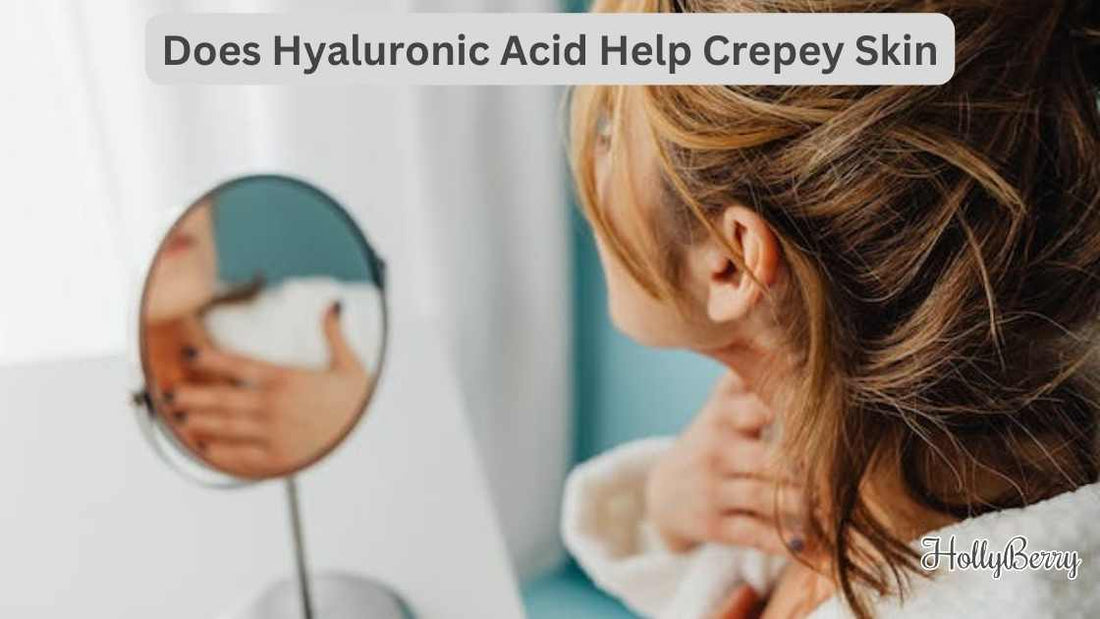
Does Hyaluronic Acid Help Crepey Skin
Share
Insights into Its Efficacy

Hyaluronic acid is renowned for its ability to retain moisture, proving to be a vital ingredient in skincare products targeting crepey skin. It effectively draws moisture into the skin, helping to hydrate and plump the appearance of areas that have begun to show signs of aging with fine lines and a paper-thin texture.
This ingredient’s capacity to augment hydration can lead to a healthier, smoother appearance, combating the lacklustre and delicate nature of crepey skin.
The condition of crepey skin, characterised by its resemblance to thin, crinkled crepe paper, typically occurs due to the natural aging process, photoaging from ultraviolet radiation, and a decline in the skin’s ability to retain moisture.
While hydration is crucial in maintaining skin's youthful resilience, the role of hyaluronic acid goes beyond just superficial moisturisation. It is integral to skin's structural integrity, binding water molecules to replenish and maintain the necessary moisture levels within the skin's layers.
Addressing crepey skin requires an approach that combines adequate protection, nutrition, and rejuvenation.
Hyaluronic acid serves as a cornerstone for treatment regimes, aiming to enhance the skin's moisture retention capabilities and supply.
When used consistently and incorporated into a comprehensive skincare routine, hyaluronic acid can support the skin’s hydration balance and contribute to reducing the appearance of crepey skin over time.
Understanding Crepey Skin and Hyaluronic Acid
Crepey skin is characterised by thin, finely-wrinkled skin resembling crepe paper, often as a result of aging or sun damage, while hyaluronic acid (HA) is a substance known for its hydrating properties. The interplay between HA and skin health, specifically addressing crepey skin, reflects an important topic in dermatological care.
Causes of Crepey Skin
Crepey skin occurs due to the breakdown of collagen and elastin fibres, critical components that confer skin's firmness and elasticity. Contributory factors include:
- Age: As the skin matures, collagen production declines.
- Sun Exposure: Cumulative UV damage can accelerate the degradation of supportive skin structures.
- Genetics: Hereditary traits can influence skin texture and resilience.
- Lifestyle Factors: Habits like smoking can exacerbate the ageing process.
The Role of Hyaluronic Acid
HA is a humectant that attracts and retains water molecules, contributing to skin's hydrated state and plump appearance. Its role is particularly significant considering its ability to:
- Bind up to 1,000 times its weight in water.
- Be naturally present in the skin, although levels decrease with ageing.
Benefits of Hyaluronic Acid for Crepey Skin
For crepey skin, HA offers multiple advantages:
- Hydration: Enhances moisture content, giving a more supple skin texture.
- Reduction in Fine Lines and Wrinkles: Fills skin's extracellular space, diminishing the appearance of wrinkles.
Optimising Skin Hydration

Order our 500ml Hyaluronic acid from our UK store
Maintaining optimal hydration levels requires a dual approach:
- Use of Hyaluronic Acid Serum: Preferably with varying molecular weights for superficial and deeper skin hydration.
- Regular Application of Moisturisers: To seal in moisture, reinforcing the skin's natural barrier.
Professional Treatments and Hyaluronic Acid
Professional interventions may include:
- Filler Injections: Utilising HA to provide immediate volume and smoothness.
- Laser Treatment and Ultrasound: These can stimulate deeper collagen production, supporting HA's effects.
Preventative Measures and Daily Care
Key actions to prevent and manage crepey skin encompass:
- Sun Protection: Consistent use of sunscreen with high SPF is critical.
- Skincare Routine: Incorporating products with antioxidants, HA serums, and targeted moisturisers for different skin types (oily, dry, sensitive).
Incorporating Hyaluronic Acid into Your Skincare Routine
Hyaluronic acid can be a key component in managing crepey skin, as it supports hydration and skin barrier function. To harness its benefits, it should be applied properly within a skincare routine and accompanied by supporting ingredients.
Application Tips for Maximum Effectiveness
To optimise the hydration effects of hyaluronic acid, it is best applied to damp skin. This practice facilitates its absorption and enhances its ability to bind moisture. Skincare products containing hyaluronic acid, such as serums, are commonly used for this purpose. A step-by-step guide would be:
- Cleanse your skin gently to remove impurities.
- Pat slightly damp: Do not completely dry your face.
- Apply hyaluronic acid serum: Use a pea-sized amount and dab onto the skin.
- Layer with a moisturiser: Seal in the hydration.
- Additions: Pair with vitamin C in the morning for protection or with retinol at night for repair.
It's important to check if the product contains sodium hyaluronate, a form of hyaluronic acid that has smaller molecules and can penetrate the skin more deeply.
Routine Maintenance and Adjustments
Skin's needs may change with the environment, stress, and ageing. Therefore, it's crucial to adjust the routine periodically:
- Dermatologist Visit: Schedule regular check-ups to assess skin's needs.
- Supplements: Consider incorporating oral supplements as advised.
- Complementary Ingredients: Products with peptides and anti-inflammatory agents like oils can support skin's connective tissue.
- Caution with actives: Balance use of glycolic acid, lactic acid, and other exfoliants to avoid compromising the skin barrier.
To maintain the benefits, regularly assess the skin's response and make adjustments to the routine in consultation with skincare experts. Hyaluronic acid can be used alongside other products, but involve a dermatologist to tailor a regimen that addresses individual concerns effectively.
